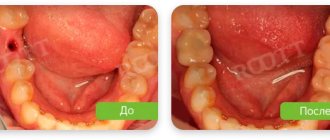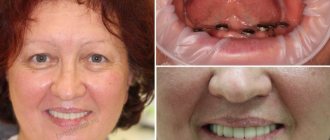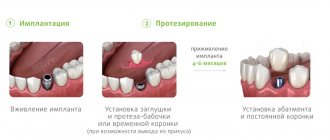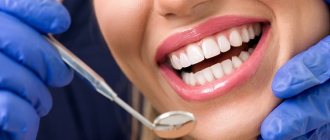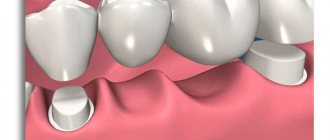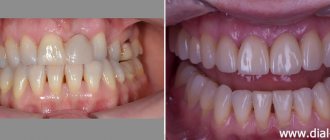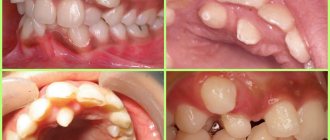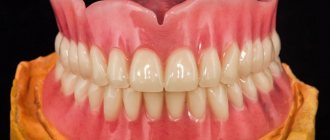Home / Articles / Restoration of chewing teeth
Every person wants to have beautiful, even, and, most importantly, intact teeth. But, unfortunately, time and lifestyle leave their mark on the condition of our teeth. In addition, as a rule, many people seek help from a doctor when they feel unwell. Consequently, the tooth is already at a significant stage of destruction and it is no longer possible to do without extensions. Dental restoration methods can help restore your teeth to their former shape or correct their imperfections.
Bridge prosthetics
The principle of installing a bridge is simple and known to many - adjacent teeth are ground down, a structure is made of three crowns - two “empty” and one solid in the middle. Empty crowns are used to cover ground teeth, and the structure is attached to dental cement. A full-bodied crown replaces a missing tooth in a row.
Advantages of the method: fast, inexpensive.
Disadvantages: traumatization of healthy teeth, since in most cases they need not only to be ground for a prosthesis, but also to be depulped. Injured teeth can soon cause new problems, and you will have to worry about restoring your dentition again.
What can modern dentistry do?
Zirconium crowns installed today most often meet all the requirements for restoring the aesthetics and functionality of teeth. How long does the recovery effect last? This question is difficult to answer unequivocally, since much depends on dental care, nutrition and lifestyle of the patient. It is possible to prolong the effect of restoration by taking preventive measures given by the doctor after the dental restoration procedure.
The best dentists and dental clinics in Moscow offer high-quality dental crowns, reviews of which can be read on the Internet. It is important to understand that the benefits of implantation, dental care both before and after restoration is a determining factor in the health and whiteness of teeth. A fairly common problem for modern people is darkened enamel. Videos of dental crowns in dentistry can be viewed on the website. The reasons for darkening of the enamel are numerous, but in some cases it is impossible to correct the color defect with the help of bleaching. And this is where aesthetic dental restoration comes to the rescue, prices that can cope with even the most complex cosmetic tasks. Of course, the cost of implanting chewing teeth, as mentioned above, is affordable; it is very difficult to distinguish the tooth being restored on your own, even in the photo. Dental problems that can be easily treated by modern dentistry are quite numerous.
Among the most popular are diastema (interdental spaces), broken teeth, chips, cracks in teeth, stains and darkened areas on the enamel, “yellow” teeth, as well as other aesthetic problems on the front and side teeth. The service life of crowns and restorations allows you to solve numerous aesthetic problems, even in cases of significant destruction of the tooth or teeth. It is important to note that when several front teeth are destroyed, complete restoration is possible in the absence of contraindications to restoration. The choice of implantation technique, as well as the choice of implant system and the choice of crown system, is best left to the doctor.
Removable dentures
Removable orthopedic structures can be made from various materials - nylon, acrylic, plastic with a metal base, etc. They can be used in cases where there is nothing to attach the bridge to, that is, to solve the problem of an end defect.
Advantages of the method: affordable price, no trauma to hard tissues or mucous membranes, the ability to correct the end defect.
Disadvantages: lack of comfort, long habituation, hygiene requires daily removal of the prosthesis and its cleaning outside the oral cavity, relatively short service life.
Indirect method of restoration of chewing teeth
The use of the indirect restoration method involves performing most procedures outside the patient's mouth. If the tooth is destroyed by more than 50%, then the installation of an inlay is required, which will make it possible to preserve the natural tissues of the destroyed tooth as much as possible. In addition, the tab will help eliminate the further development of caries and the need for pulp removal in the future. The use of ceramic inlays for the restoration of chewing teeth will restore not only the appearance of the tooth to its ideal condition, but also its functionality.
Classic implantation
If one tooth or several scattered defects are missing, you can use classic dental implantation. Its essence lies in the fact that an implant is surgically installed in place of the extracted tooth and takes root without any load. After complete engraftment, which is after 2-4 months for the lower jaw, and after 3-5 months for the upper jaw, the patient is given permanent prosthetics. It is important to choose strong and durable materials for prosthetics. So, for example, ceramics are not suitable for the chewing zone - they are aesthetic and very naturalistic in appearance; they will not withstand chewing loads for a long time. In this case, metal ceramics or zirconium dioxide are well suited as prostheses. Zirconium can be used on absolutely everyone, and metal ceramics can only be used on patients who do not have allergic reactions to metals.
Advantages of the method: reliability, durability, no trauma to other teeth in the row, absolute comfort in using dentures on implants.
Disadvantages: the need for surgical intervention, high cost compared to conventional prosthetics.
How dental restoration is done: from preparation to final processing
- First comes a set of preparation activities. The doctor carries out hygienic prevention of the oral cavity, cleaning the dental covering from plaque and tartar using an Air Flow ultrasonic device. The natural color of the patient’s tooth enamel is determined using a tint scale, and then the appropriate color of the photopolymer composite is selected.
- If there is a need for this, tissue preparation is carried out: removing old filling material, drilling out areas affected by caries. Restorative measures are impossible without first eliminating existing dental problems.
- A latex scarf or rubber dam is required, which isolates the oral cavity from saliva and moisture. The penetration of moisture between the tooth surface and the restorative material will lead to the formation of carious lesions and destruction of the structure under the influence of daily loading processes. If more than half of the tooth is missing, a pin is placed for strength.
- The next stage is treating the tooth coating with etching gels, applying an adhesive layer to ensure gluing of the material and dental tissues.
- To restore a dental crown, a technique is used to apply layer-by-layer composite material of various shades to the surface of the tooth. This method allows the tooth to look natural without standing out from the rest.
- The final stage includes introducing the tooth into the bite, modeling the final shape using grinding and polishing tools, in particular removing irregularities and adding shine.
Single-stage implantation
Separately, it is worth mentioning about one-stage dental implantation in the chewing zone. If at a dentist's appointment you hear a disappointing verdict that a tooth needs to be removed, do not rush to the surgeon's office. Find out from your dentist if there are any indications for immediate implantation in your case.
This is a protocol that is minimally invasive. The problematic tooth is removed and an implant is immediately inserted into the fresh socket. There is no need to cut the mucosa and apply stitches. In addition, one-stage implantation saves time, since the patient does not need to wait for the wound to heal after removal so that classical implantation can be done.
Advantages of the method: minimal trauma among all implantation protocols, reliability, longevity of the result.
Disadvantages: not suitable for all patients. If the bone tissue under the diseased teeth is destroyed or thinned out, it will not be possible to place an implant at once.
Direct aesthetic restoration of posterior teeth
It includes the following steps:
- Teeth cleaning, selection of composite material by color, pain relief.
- Removal of affected tissue.
- Isolation of the tooth from moisture.
- Installation of a pin into the root canal.
- Tooth extension.
If there is significant tooth decay, it is first necessary to identify the reasons that led to this, and then consider possible restoration methods.
Unfortunately, some dentists are inclined to remove a tooth that is more than half destroyed. But qualified specialists are still inclined to give the “native” tooth the opportunity to last as long as it can.
The causes of tooth decay are different:
- untreated caries;
- tooth injury;
- loss of filling;
- bruxism.
If you decide to save a tooth through restoration, then this must be done as quickly as possible so that the neighboring teeth are not destroyed. Dental restoration using a pin is considered the most reliable. Installation of a pin is indicated when there is almost no natural tissue left from the tooth. There are several types of pins:
- silver;
- fiberglass;
- anchor;
- titanium.
CONTENT
MAESTRO OF DENTISTRY LIMA ABBASOVNA MAMEDOVA
L. A. Mamedova.
ON THE. Dmitrieva. E.V. Khasanova Use of diode laser in the treatment of chronic apical periodontitis
L.A.
Mamedova Anatomical and functional features of chewing teeth; their significance for restorations and occlusal correction
E.M.
Roshin, V.A. Khvatova Application of an electronic axiograph (Arcus Digma) in everyday practice
S.V.
Grishkov, M.S. Grishkov Experience of clinical application of self-adhesive universal dual-curing composite cement Relux U100 from ZM ESPE
Dealer Conference “STIdent”, Nice, February 2008
"STIdent": the feeling of belonging is very valuable
Jochim Klimek
The role of the protective layer of calcium fluoride in preventing the development of carious lesions of hard dental tissues
Yu.V.
Kuzovkova Competition for the most interesting clinical case 2007 Summing up
I.I.
Dunaevskaya, L.A. Zharkova Dentofacial anomaly as part of a rare general somatic disease
V.A.
Kunin The best dentists in Russia!
V.V.
Sadovsky, D.Z. Choniashvili, D.A. De, S.N. Sheobo Molecular genetic methods of diagnosis and analysis of the data obtained using computer programs
CHAMPIONSHIP OF DENTAL EXPERTISE Nominations are announced for the Championship of Dental Excellence of Russia in 2008 “Best work in aesthetic dentistry” “Teeth whitening” “Best work in orthopedic dentistry” “Prevention of dental diseases” "Clinical periodontology" "Analgesia and emergency care in dentistry"
O.E.
Khidirbegishvili Classification of restoration techniques
Clinical gnathology
Average price for composite dental restoration in Moscow
The final cost of composite dental restoration depends on:
- types of composite material;
- number of dental surfaces treated;
- recovery difficulty level;
- selected clinic;
- qualifications of the doctor performing artistic restoration of teeth;
- the number of teeth that need to be restored;
- the need to pre-clean or treat teeth and gums.
The average price for artistic composite dental restoration in Moscow is from 4,500 to 13,000 rubles per unit. This price includes:
- photodiagnosis of teeth;
- anesthesia;
- rubber dam application;
- direct tooth restoration with high-quality heliocomposite material with precise selection of the optimal crown color;
- checking occlusion after dental restoration;
- recommendations for oral care after restoration.
Consultation with a dentist who specializes in composite restoration is free!
For complete dental restoration, just one visit to the dentist’s office is enough.
How is dental implantation performed?
The implantation procedure provides for separate prosthetics if 1-2 dental units are lost, and a dental bridge for more extensive jaw defects. The classic method, known for 50 years, is two-stage implantation.
With its help, you can gradually implant an implant, wait until it takes root, and perform prosthetics. The treatment period reaches 3-6 months.
Implantologists at Family Dentistry have several treatment protocols at their disposal, allowing you to choose the most suitable one in each specific case.
Treatment of tooth wear
What is tooth abrasion?
The loss of hard tooth tissue (enamel) during a person’s life is a normal process and is adaptive in nature, since our teeth are constantly in contact with each other. When chewing, the teeth adapt to various movements of the lower jaw, and upon contact, areas are formed that not only increase the chewing surface of the teeth, but also facilitate gliding. This significantly reduces the load on the temporomandibular joint. This natural abrasion of tooth enamel is called physiological.
What is pathological abrasion?
Pathological or increased abrasion
proceeds according to a different scenario.
The process ceases to be sluggish and the rapid loss of hard tooth tissues leads to a sharp decrease in the height of the tooth and the balance between its above and intraosseous parts is disrupted. In addition to tooth enamel, tooth dentin is also involved in the abrasion process. The chewing tubercles of the teeth quickly wear out and the teeth become flat “like a table,” which not only makes chewing difficult, but also speech function suffers, especially when the cutting edge of the anterior group of teeth wears off.
Pathological abrasion is always accompanied by discomfort for the patient:
- Reaction to temperature and chemical stimuli.
- The height of the lower third of the face decreases.
- The nasolabial folds become more pronounced.
- Dystrophic disorders in the temporomandibular joint (clicking).
- The appearance of pain in the joint when chewing.
- Chewing function decreases.
- The lower jaw moves posteriorly.
- The face takes on an senile expression.
- The volume of the oral cavity decreases and breathing problems appear.
- The person begins to stoop, and dystrophic disorders appear in the spine.
- And as a consequence, problems in the human nervous system, as well as the digestive, respiratory, and cardiovascular systems.
IMPORTANT:
According to various estimates, due to dysfunction and condition of the masticatory apparatus and the changes described above, a decrease in human life expectancy can occur by 15 years or more. Against this background, smoking becomes harmless entertainment.
What is the cause of pathological abrasion.
Functional inferiority of hard dental tissues
.
In this case, the process can be hereditary, congenital (disorders of amelo- and dentinogenesis) or acquired (metabolic disorders, dysfunction of the endocrine, vascular, nervous and other systems).
But the most common reason is excessive functional load on the tooth tissue.
This category of causes includes bite pathology, partial edentia (the absence of part of the teeth), malocclusion, the use of low-quality dentures, bruxism, errors in prosthetics of defects in the dentition, errors during filling carious cavities, “flat” fillings that do not in any way follow the shape of the chewing surface of the teeth. , chronic dental trauma (bad habits).
IMPORTANT: All these factors lead to irreparable consequences, in the form of pathology of the temporomandibular joint.
How it goes.
Like every disease, pathological abrasion varies:
By degree:
- I - abrasion of the enamel of the cutting edges and cusps of the tooth.
- II - Reduction by 1/3 of the length of the tooth crown.
- III – wear down 2/3 of the length of the tooth crown.
- VI – reduction of the tooth crown by more than 2/3.
The shape
is divided into horizontal, vertical and mixed. And in terms of extent, it can be local on several teeth or cover the entire dentition and be called generalized.
Consequences of pathological tooth wear.
Intensive loss of hard dental tissues leads not only to serious functional
disorders in the temporomandibular joint, but also to aesthetic problems.
- Loss of bite height not only negatively affects a person’s appearance, but also brings a number of problems when trying to put a filling on a tooth or carry out aesthetic restoration of teeth using veneers made of composite materials.
- It is not possible to install a crown or implantation at all.
- Dysfunction of the temporomandibular joint (TMJ)
interferes with proper chewing of food, speech formation, and all this is accompanied by pain and a “clicking” of the joint when opening or closing the mouth.
IMPORTANT:
A vicious circle arises that is very difficult to break. Functional overload in the absence of a number of teeth or malocclusion leads to pathological abrasion of the teeth, and this leads to an increase in the functional load necessary for chewing food, which contributes to even greater abrasion of the hard tissues of the teeth.
Methods for treating pathological abrasion.
Rehabilitation of patients is very long and requires a lot of experience and knowledge from the doctor. Only a doctor can be the first to diagnose the first signs of this disease when examining a patient. The treatment process can take more than one month and requires the patient to be patient and follow all the doctor’s recommendations. Depending on the degree and form of the disease, various treatment methods are used.
For I and II degrees
The main goal of treatment is to stabilize the process and prevent further progression of the process. For this purpose, inlays and crowns can be made on teeth. Modern composite materials, due to their high adhesion and strength, in some cases make it possible to save teeth, avoid pulp loss and achieve
long-term (5-10 years) therapeutic and aesthetic effect
using direct or indirect restoration (with Wax-up modeling)
. Orthodontic treatment is also carried out if necessary.
At stages III and IV
diseases, the height of the lower third of the face decreases and dysfunction of the temporomandibular joint is observed. The treatment takes place in stages, since the specialist faces two tasks simultaneously:
- Restoring the lost interalveolar height between the dentition allows you to normalize the functioning of the temporomandibular joint and relieve it from overload.
- Complete restoration of the anatomical shape of the teeth.
Treatment of abrasion in this case will be orthopedic.
Restoration of the bite height occurs when the patient wears a special joint splint, under the supervision of a doctor. During the adaptation period, temporary mouthguards and crowns are used, which allow the jaw to get used to the new position. The best option is a non-removable design, since a person will not have the opportunity to disrupt the healing process. Each stage can take a long time and during this time the patient must visit the dentist
, especially if any unpleasant sensations appear.
IMPORTANT:
The more serious the damage to the dental tissue and the longer the patient ignores it, the more difficult the treatment process is.
Diagnosis of increased tooth wear.
Diagnosis of increased tooth wear is based on patient complaints and the study of external
signs. Abnormalities can be detected by examining the teeth. Differential diagnosis is only required to distinguish physiological abrasion from pathological, localized from generalized form, as well as to determine the degree of pathology based on the height of the loss of hard tissues of the dental crowns, which is important when choosing treatment tactics. Pathological abrasion of individual teeth must be distinguished from traumatic lesions, caries and non-carious lesions, wedge-shaped defects, and erosion.
Excessive functional loads on tooth tissues provoke the occurrence of pathological abrasion. This category of reasons includes specific chewing of food, partial edentia (missing part of the teeth), malocclusion, the use of low-quality dentures, bruxism (TMJ dysfunction) or errors in fillings and prosthetics.
In this case, to obtain a complete picture, in addition to external examination, palpation of the masticatory muscles and the TMJ area, and corresponding measurements, plaster models of the jaws are studied, and hardware studies, electroodontodiagnosis, radiography, tomography of the TMJ, and electromyography of the masticatory muscles are also carried out.
Restoration of worn teeth.
Despite the fact that increased abrasion is quite easily diagnosed, eliminating
existing disorders is a complex process, which is associated with a variety of reasons causing the development of these pathological signs. The choice of the most appropriate tactics for dental restoration is carried out in each case in accordance with the individual characteristics, stage and nature of the lesion, and its causes.
It will be possible to quickly restore areas of increased tooth sensitivity, as well as the aesthetics of the anterior zone, with the help of composite materials. Restoration of worn teeth
can be carried out using modern high-strength microhybrid light materials and through prosthetics. When making prosthetics, it is optimal to use ceramic inlays or crowns for these purposes, which significantly increases the cost of treatment. Total prosthetics with expensive zirconium dioxide structures are not always justified for such pathology and are an excessive procedure. Such designs may be relevant if tooth wear is accompanied by other orthopedic problems or the patient is contraindicated for implantation.
Service cost.
Prices for treatment in our clinic
justified and justified. Our patients appreciate the professionalism of our specialists, the durability of the restorations, and the excellent external aesthetics of all work. But the most important thing in the doctor’s work is the preservation of the functional characteristics of the dental system, 100% elimination of pain and discomfort. We place high demands on the quality of work and set strict internal standards.
The cost of treating pathological tooth abrasion depends on the degree of development of the process and the methods used (therapeutic or orthopedic). Generalized tooth abrasion, affecting all teeth at once, requires an integrated approach and systemic action. A local problem, as a rule, can be eliminated in 1 visit. It is important to identify the causes of increased tooth wear. Elimination of the provoking factor will avoid relapse in the future.
Results of the procedure
The final result directly depends on the skills of the dentist who performed the restoration. Not only professional skills play an important role, but also artistic and sculptural abilities. The natural properties of tooth enamel should also be taken into account: firstly, the shade and transparency of the coating changes from the cutting edge to the gum. If these nuances are not taken into account, the restored tooth will stand out from the rest.
Advanced composite materials currently used in dental clinics have properties that mimic the natural characteristics of tooth enamel, in particular transparency. The professionalism of the doctor in combination with high-quality materials allows you to achieve excellent results, achieving optimal aesthetics of the dentition and the return of previous functionality.
To extend the life of the restorative composition, it is highly advisable to grind and polish the material during your annual mandatory visit to your dentist. Since the composite material shrinks and is stained by external colorants, such as in food, periodic treatment will keep the restorative structure in perfect condition. Changes in color and shape are not so significant, but prevention should not be ignored.
Types of composite material for high-quality dental restoration
The German-American composite composition Estet X is the optimal solution. A complete aesthetic dental restorative system, highly polishable, with the physical properties of the most sought after hybrid dental composites. The material for artistic restoration is distinguished by its sculptural plasticity, holds its shape, and is comfortable for the dentist to work with. Absolute naturalness as a result of composite dental restoration.
Filtek (Filtek) is a photopolymer material, a nanocomposite, which is often called a gel filling. Optimal material for high-quality restoration of chewing and anterior teeth. High strength, availability of multi-layer dental restoration, low shrinkage, wear resistance, the material can be polished well, a wide range of shades for dental restoration.
Doctors at the 32 Dent clinic perform high-quality aesthetic restoration of teeth using Estet X, Filtek materials, etc.
Why is it important to promptly restore chewing teeth?
In place of lost teeth, bone tissue gradually decreases, and implantation cannot be done using all methods. Unfortunately, this is not the only problem:
- the functioning of the stomach and intestines is disrupted, dyspepsia and flatulence appear;
- the contours of the face change, the cheeks fall in, wrinkles appear;
- diction and bite changes, the growth of the remaining teeth is disrupted.
Such consequences are unacceptable and significantly worsen a person’s quality of life. Therefore, it is imperative to get rid of the defect in the dentition. This can be done with the help of a dental bridge, removable denture and, preferably, implantation.
